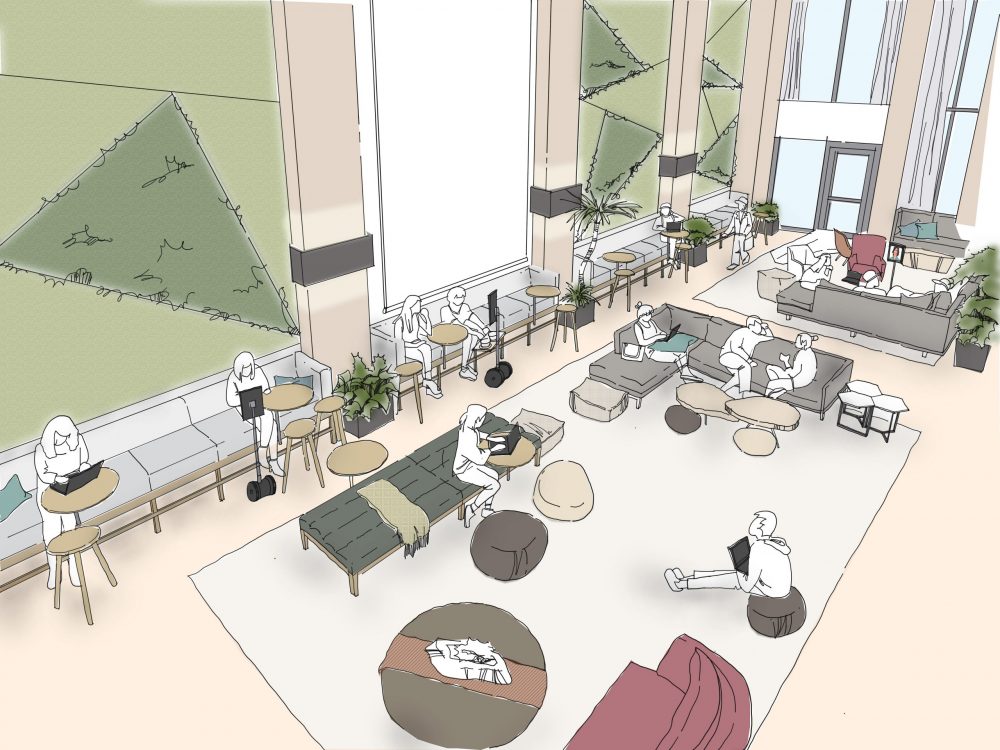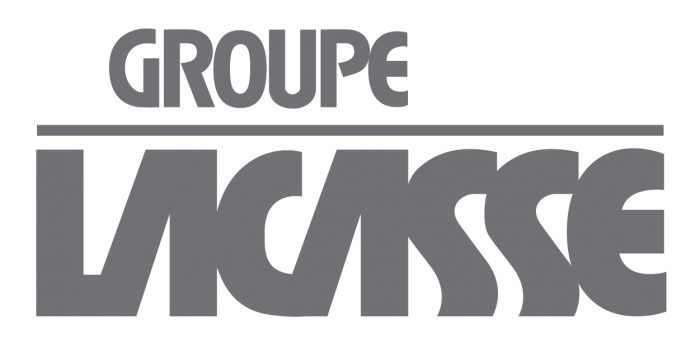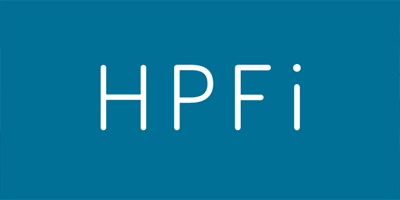As new hybrid work environments become more prevalent, the Perkins Eastman’s Design Strategy team explores the concept of the Fourth Place – a place that combines the functions of home, work, and public space.

We met the leaders of Perkins Eastman’s Design Strategy Team, Rebecca Milne and Scott Fallick, when Chicago’s annual NeoCon event had to pivot to virtual content. Work Design Magazine and theMart sought a virtual way to discuss their original topic, Defining and Designing a Successful Fourth Place, and how that may have changed in the advent of the COVID-19 era. They originally planned to explore the concept of the Fourth Place – a place that combines the functions of the first three: home, work, and public environments. As new hybrid work environments become more prevalent, they had planned to discuss this emerging concept’s value to the future of work.
Ironically, we have almost all been forced into unanticipated work environments because of COVID-19. Companies have had to regroup and reinforce not only the ability of their employees to work in their home environments but come together remotely, pushing the available technologies to create a new workplace, almost out of thin air. Already poised to discuss new and evolving work environments, we asked the team some questions to find out what they are working on and how they are exploring solutions across their varied clientele and portfolio.
Six months into the COVID-19 pandemic the A&D and CRE communities are moving into the implementation phases of whatever the “new normal” may be. While there is still no vaccine, or a clear picture of how and when it will be safe for a unilateral return to the office, companies are evaluating their options. The Design Strategy team at Perkins Eastman has been hard at work with these companies, developing protocols for new physical space scenarios that will support their business as we move forward into “What’s Next”.
As you have been working with your clients, what are the key elements of the workplace that they are concerned about?
There have been concerns about the structure and role of the workplace for some time now: long, tedious commutes, a lack of private/focused space, work over wellness, among others. While many offices in America are open plan, heralded as a place for collaboration, most employees find them disruptive, even stressful. We’ve known this for some time but change in office design was an ongoing transformation.
COVID-19 has encouraged ideas about new work models. At its base, open offices are less conducive to the physical distancing protocols required to diminish COVID-19 transmission. With the success of remote working, some people wondered if we even needed the office. But from our own staff surveys, client roundtables, and individual research we found that while employees enjoy remote working, they still desire some office life and culture.
We have been helping clients write policies of process that reflect work models that work for them, asking questions like: What does a remote workforce look like for your business? How can your office reflect this new way of working? In other words, in a post COVID world, what is the role of the office and what does it look like?
We have found that clients who adopt these new hybrid work models can actually help their open office achieve its original intention as a facilitator of collaboration. For example, when paired with the flexibility of virtual collaboration and a physical office setting, the office can become so much more than the “walls” of the workplace.

Are the concerns more weighted toward logistics or culture?
We think these concerns are one and the same. The logistics influence the culture: what new policies say, will inform how the new culture works. For example, in a work culture used to seeing each other every day, they may see each other once a month in a future with more permanent remote working. With less physical interaction, we have to ask: how do we engage that remote workforce while they aren’t in the office? How do we maintain that culture through policy and logistics? We researched and compiled ways to engage a remote workforce that we use within our own firm. We focus on policies that strengthen team identity, check-in with employees, help make working from home accessible and comfortable, among others. We think Change Management and Transition strategy will be essential to help organizations develop new ways of working.

What do you think the main drivers of physical changes, space reorganization will be so that there is a comfort level for workers returning to the office?
Perkins Eastman implemented a national Remote Work Survey, gathering data from 645 employees across 10 U.S. office locations. Survey respondents answered questions about their day-to-day experiences and feelings since the start of stay-at-home orders, including factors related to remote work, wellness, communication, and collaboration. Overwhelmingly, we found employee safety and over all wellness to be a big driver. There will be new expectations from workers around their health within the office. A demand for improved air quality, touchless technology, access to outdoor spaces, and more. These new expectations go hand-in-hand with updated cleaning procedures where WELL and other sustainability certifiers are changing their policies to prepare for a post COVID world.
In addition to our survey, we hosted 10 virtual roundtable discussions with 41 industry leaders from a variety of sectors across the United States. The conversations focused on themes of adapting to change, connecting with each other, and strengthening organizations for the future. At the end of each we provided all our clients “Digital Doggy Bags,” insights into our conversations and their current situation. Drivers for change were internal as well as external: challenging the work from home stigma among management, recalibrating how much we work from the hours we are working to the deliverables we produce, optimizing the home office for workplace creativity, and building resilience in the office against future disruptions like COVID-19.

As you work through the design problems for each client, what are you seeing across the furniture, flooring, textiles (all related industries) that will support the design changes for whatever the new work environment may be?
Our Sustainability team has done a lot of research on materials. We plan to discuss this in more detail in a future article on this question in collaboration with our sustainability team to talk through their research and ideas.
To read more about Perkins Eastman’s pioneering initiatives and thought leadership check out their blog, Human By Design.
The initial topic of your planned presentation was “The Fourth Place “. As we have discussed this topic in the context of today’s situation it is interesting to note that your team’s thinking about how the workplace may evolve in a way that in more closely aligns with the fourth-place concept.
As we have been evaluating design solutions, we have also been re-thinking some of our initial conclusions. We hope to explore this in detail as we progress with our research and ongoing work with clients. The role of the office post-COVID will shift to not just a combination of third places attributes (refuge, personalization, and gathering) but other attributes the office didn’t meet previously; these will be combined with the new and evolving demands of post-COVID workplaces. For example, the wholesale shift to remote work has vastly grown the capability and necessity of the virtual environment. We wonder how our new online world will be assimilated into new fourth place principles. We also think the future office will take on much more of the fourth place role post-COVID; it won’t just be a space focused on heads-down work, it will need to be filled with amenities in the same way a co-working space draws users and fosters community.

The impact on the commercial real estate market will be significant. What are your thoughts on this?
We are already seeing a considerable amount of space being offered for sublet as companies are going to shed expensive real estate. Do we need to address the upheaval there? For example – effect on urban markets – the move “back to the urban core” to lure workers, now may force some companies to “go back to the suburban office parks”.

We like to think of this question from two scales, the Micro and Macro in terms of office design. On the micro level, we think about each individual organization’s needs. Depending on their new workplace policies and the company culture they want to foster, we think many companies will take a closer look at their real estate portfolio. On the macro scale, we are thinking about how to source different space types; how office building designs will change to meet new tenant expectations/needs; how landlords may change their program offerings. We think tenant spaces will look quite different in a post-COVID world, spaces that reflect not just safety guidelines, but new office guidelines based on alternative work models that make the office a more collaborative, social, and virtually accessible space.
Adding to our initial thoughts on the evolving fourth place, we wonder what macro office design guidelines will look like when the office is much more of a social hub: a place for mentorship, networking, and connection. How can we leverage building designs to foster these new needs?
There will be certainly be many changes as we all return to work, but many of them will be exciting opportunities. We are eager to facilitate these new trends in workplace design; to listen to our clients and their employees; to participate in the creation of the workplace of the future.





